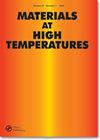Practical application of an ultra-miniature creep test to the remaining creep-rupture life prediction using an iso–stress approach for in-service boiler piping of modified 9Cr-1Mo steel
IF 0.9
4区 材料科学
Q4 MATERIALS SCIENCE, MULTIDISCIPLINARY
引用次数: 0
Abstract
ABSTRACTA practical procedure for predicting the remaining creep-rupture life of in-service boiler pipes under their operating conditions is proposed and discussed in this study. Tests were conducted on a coupon obtained using electric discharge sampling equipment from the outer surface of an in-service boiler pipe of modified 9Cr-1Mo steel. An ultra-miniature creep (UMC) specimen machined from the coupon was employed for the tensile creep test. Focusing on an iso–stress approach that has potential for the remaining life prediction using a limited test data, its suitability has been discussed. Test results indicate that the iso–stress approach can be applied to predict the remaining creep-rupture life using the UMC testing method with high accuracy. Furthermore, an examination of the high-temperature oxidation resistance of the UMC specimen indicated that oxidation had little influence on the rupture time.KEYWORDS: In-service pipingmodified 9Cr-1Mo steelremaining creep life predictionultra-miniature specimeniso–stress approachLarson–Miller parameterMonkman–Grant relationshiphigh-temperature oxidation Disclosure statementNo potential conflict of interest was reported by the author(s).超小型蠕变试验在等应力法预测9Cr-1Mo改性钢在役锅炉管道剩余蠕变断裂寿命中的实际应用
摘要本文提出并讨论了在役锅炉管道在运行工况下的剩余蠕变破裂寿命预测的实用方法。利用电火花取样装置对在役9Cr-1Mo改性钢锅炉管道外表面试样进行了试验。采用超小型蠕变(UMC)试样进行拉伸蠕变试验。重点讨论了利用有限的测试数据进行剩余寿命预测的等应力方法的适用性。试验结果表明,等应力法可以较准确地预测UMC试验方法的剩余蠕变断裂寿命。此外,对UMC试样的高温抗氧化性能进行了测试,结果表明氧化对断裂时间的影响很小。关键词:在役管道改性9Cr-1Mo钢剩余蠕变寿命预测超微型试样应力法larson - miller参数monkman - grant关系高温氧化披露声明作者未报告潜在利益冲突。
本文章由计算机程序翻译,如有差异,请以英文原文为准。
求助全文
约1分钟内获得全文
求助全文
来源期刊

Materials at High Temperatures
工程技术-材料科学:综合
CiteScore
1.90
自引率
15.40%
发文量
58
审稿时长
>12 weeks
期刊介绍:
Materials at High Temperatures welcomes contributions relating to high temperature applications in the energy generation, aerospace, chemical and process industries. The effects of high temperatures and extreme environments on the corrosion and oxidation, fatigue, creep, strength and wear of metallic alloys, ceramics, intermetallics, and refractory and composite materials relative to these industries are covered.
Papers on the modelling of behaviour and life prediction are also welcome, provided these are validated by experimental data and explicitly linked to actual or potential applications. Contributions addressing the needs of designers and engineers (e.g. standards and codes of practice) relative to the areas of interest of this journal also fall within the scope. The term ''high temperatures'' refers to the subsequent temperatures of application and not, for example, to those of processing itself.
Materials at High Temperatures publishes regular thematic issues on topics of current interest. Proposals for issues are welcomed; please contact one of the Editors with details.
 求助内容:
求助内容: 应助结果提醒方式:
应助结果提醒方式:


